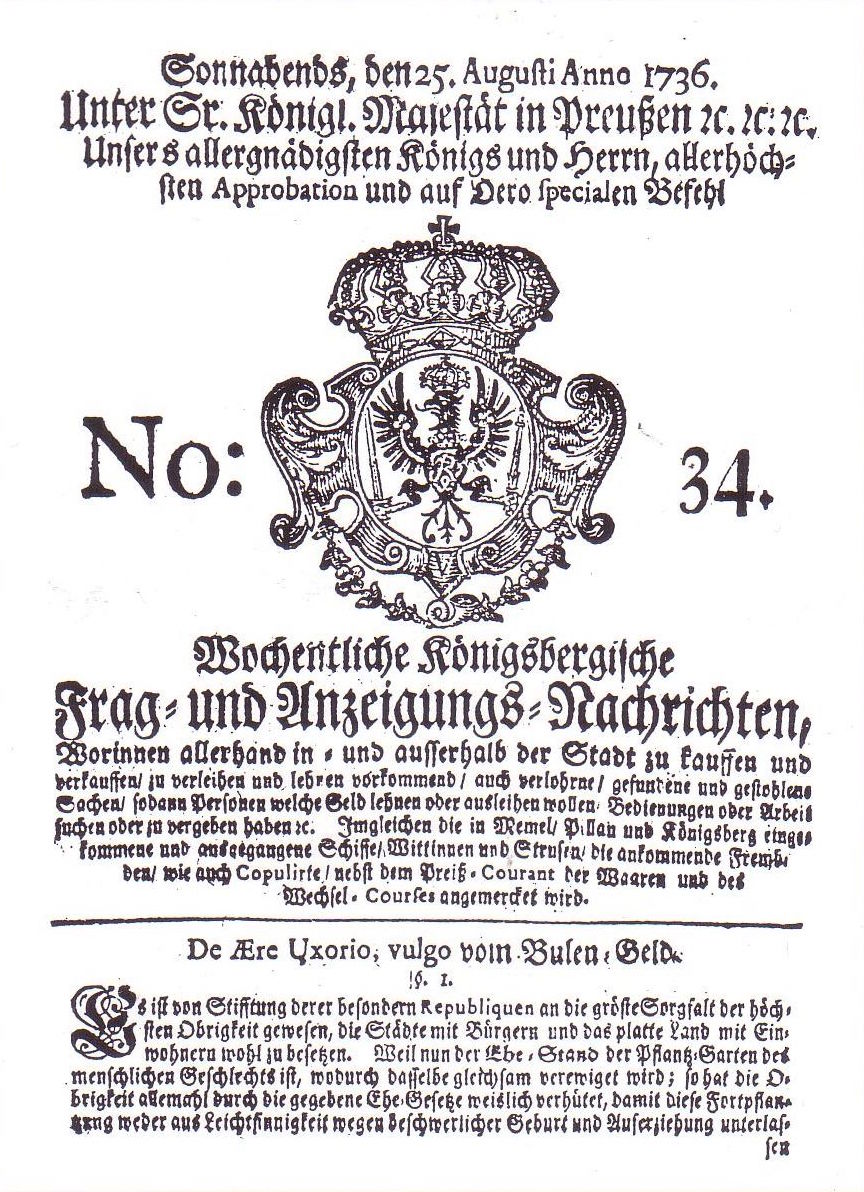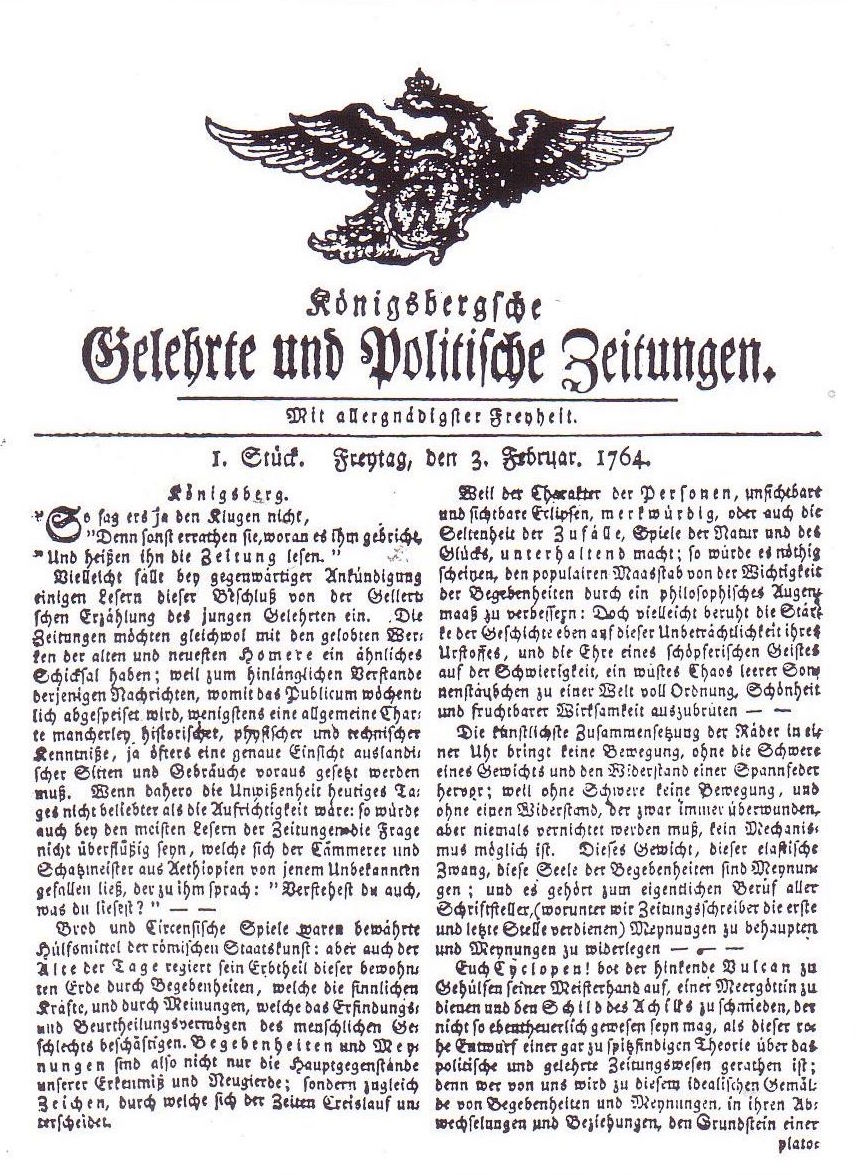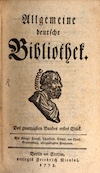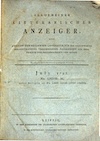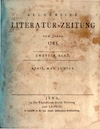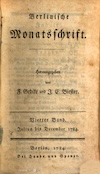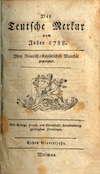Publishers and Periodicals
Following is a list of publishers and periodicals relevant to Kant’s publishing activity, based in part on Meckelburg [1840], Hagen [1850b], Dreher [1896], Forstreuter [1932], Rehberg [1942], Gause [1996, 2: 127-31, 232-43], and Kohnen [1994]. Dietzsch [2003, 125-30] offers a helpful discussion of the censoring of publications in Könïgsberg (the duties for which typically fell on the four faculty deans [more]).
Periodicals listed in the Index (to the left) and that published something by Kant have an asterisk (*) preceding their name.
The production of books involves a number of skilled roles, apart from the writing of the book, and in particular (1) a publisher (Verleger) who paid the author and oversaw the editing and production of the book, (2) a printer (Drucker) who owned and operated the press, and (3) the bookdealer (Buchhandler), who sold and distributed the book to other bookdealers or directly to readers. A reliable and local source of paper was also important. These roles were often found in the same person in the earlier years. Kant’s early publishers (Dorn, Driest, Kanter, Hartung) were publisher, printer, and book dealer (Kanter also owned his own paper mill in Trutenau) and so with these the printing was always done in Königsberg and Kant was able to make corrections to the proof sheets. This changed once he published with Hartknoch (in Riga) who used the printer Grunert in Halle; also with de la Garde (Berlin), who used the printer Wegener (Berlin) for Kant’s Critique of the Power of Judgment, and Kant’s last publisher, Nicolovius (Königsberg), made use of several different printers in Leipzig or nearby.
Five printing houses existed in Königsberg in the 18th century: (1) Gottfried Hallervord was the last of three generations to run this firm, which closed with his death in 1759. (2) Christoph Gottfried Eckhart (1693-1750), who received his privilege in 1722, had worked a time for Hallervord. Eckhart’s firm (on the Kneiphof side of the Schmiedebrücke) was bought by (3) Johann Heinrich Hartung in 1746, who had moved from Erfurt to Königsberg, first worked at the print-shop (Druckerei) of Johann Stelter, married his daughter, and assumed control of the print-shop in 1734. (4) Philipp Christoph Kanter opened a print-shop on the Altstadt Schmiedegasse, and in 1732 expanded it to include a bookretailing business. Both Kanter and Hartung formed heavy competition for (5) Johann Reußner, who had arrived in Königsberg in 1639 from Rostock, received a printing privilege in 1640 and with his sons published the Königliche Preußische Fama (1709-40), followed by the Neue Merkwürdigkeiten von politischen und gelehrten Sachen (1741-), as well as the “Intelligenzblatt” Wochentliche Königsbergische Frag- und Anzeigungs-Nachrichten (1727-74, continued afterwards under different names). His son Johann Friedrich Reußner continued the newspaper, died in 1742, and three years later his widow married the French judge Johann Ludwig L’Estocq [bio] (later a professor of law at the university) who then sold the print-shop and newspaper to Cabrit (1750), who sold it the following year to Hartung [Meckelburg 1840, 33-35].
Kant’s Publishers
The following are publishers of Kant’s books and pamphlets (articles and notices that he published are listed below, under Königsberg Periodicals and Other Periodicals).
Dorn [Königsberg] [top]
Kant’s publications: 1747 [Living Forces].
Publisher: Martin Eberhard Dorn [bio] [Meckelburg 1840, 32-33]
Petersen [Königsberg] [top]
Kant’s publications: 1755 [Theory of the Heavens].
Publisher: Johann Friedrich Petersen
Petersen was the Hofbuchhändler for the duchy of Courland and Semgallen, and on 28 December 1754 asked permission to open a publishing business in Königsberg; this was eventually declined the following spring (24 March 1755), presumably on the basis of complaints by the other local publishers of his unscrupulous practices [Dreher 1896, 174-75].
Driest [Königsberg] [top]
Kant’s publications: 1756 [Theory of Winds], 1757 [West Winds], 1758 [Motion and Rest], 1759 [Optimism], 1760 [Funk].
Publisher: Johann Friedrich Driest [bio] [Meckelburg 1840, 33].
Hartung [Königsberg] [top]
Kant’s publications: 1755 [New Elucidation], 1756 [Physical Monadology], 1775 [Races of Mankind], 1790 [Fanaticism].
Publisher: J. H. Hartung [bio] (from 1746 to 1756), Hartung's Widow & others (from 1756 to 1766), G. L. Hartung (from 1766 to 1798). [Dreher 1896, 165-72]
Kanter [Königsberg] [top]
Kant’s publications: 1762 [False Subtlety ], 1763 [The Only Possible Argument] [Negative Magnitudes], 1764 [Beautiful and Sublime], 1765 [Announcement], 1766 [ Dreams of a Spirit-Seer], 1770 [Inaugural Dissertation].
Publisher: Johann Jakob Kanter [bio] (from 1760 to 1781). See also Kant’s essays published in Kanter’s newspaper, the KGPZ.
Hartknoch [Riga] [top]
Kant’s publications: 1766 [ Dreams of a Spirit-Seer],[1] 1781 [Critique of Pure Reason], 1783 [Prolegomena], 1785 [Groundwork], 1786 [Metaphysical Foundations], 1787 [Critique of Pure Reason, 2nd ed.], 1788 [Critique of Practical Reason].
Publisher: Johann Friedrich Hartknoch [bio].
[1] Apart from the printing by Kanter (see above), this work was also printed twice by Johann Friedrich Hartknoch (Riga and Mitau), also in 1766.
Lagarde [Berlin] [top]
Kant’s publications: 1790 [Critique of the Power of Judgment].
Publisher: François Théodore Lagarde (1756-1824). He used the Berlin printer Grunert, and Kiesewetter (who lived in Berlin) corrected the proofs on Kant’s behalf.
Nicolovius [Königsberg] [top]
Kant’s publications: 1790 [Discovery [Against Eberhard]], 1793 [Religion], 1795 [Perpetual Peace], 1796 [Soemmerring], 1797 [Metaphysics of Moral], 1798 [Conflict of the Faculties], 1798 [Anthropology], 1798 [Making Books], 1803 [On Education].
Publisher: Friedrich Nicolovius [bio] was principally Kant’s publisher, but he also owned a bookshop from which he supplied Kant with unbound copies of books.
Göbbels and Unzer [Königsberg] [top]
Kant’s publications: 1802 [Physical Geography].
Publisher:
Other Publishers [top]
1764 [Prize Essay], 1786 [Remarks on Jakob], 1800 [Preface to Jachmann].
Königsberg Periodicals
Königlich privilegierte Preußische Staats-, Kriegs- und Friedenszeitung [KPPSKF] [top]
Publisher: Hartung [bio].
Location: Königsberg.
Dates of Publication: 1752-1757, 1758-1850.
Frequency: Published twice weekly (Monday and Thursday).
Kant’s publications: 1783 [Review of Schulz]
Notes: Commonly referred to as the Hartungsche Zeitung. Wasianski [1804, 117] notes that Kant’s servant, Martin Lampe [bio], had picked up and then returned this paper for Kant twice each week for over thirty years. In Kant’s Nachlaß we find [AA 21: 138]:
“Montag u. Donnerstag werden die Hartungsche Zeitungen abgeholt und alsdann dem HE Joseph Motherby abgegeben.”
Kant’s review of Johann Heinrich Schulz’s Versuch einer Anleitung zur Sittenlehre für alle Menschen appeared in a monthly one-sheet insert called Räsonnirendes Bücherverzeichnis that, according to Hamann, began in February 1782 (see his 9 Feb 1782 letter to Hartknoch [Briefwechsel, 4: 366]).
Wochentliche Königsbergische Frag- und Anzeigungs-Nachrichten [WKFAN] [top]
Publisher: Reußner/Hartung.
Location: Königsberg.
Dates of Publication: 1727-1774. Successor: Königsberger Intelligenz-Zettel (see)
Frequency: Published weekly, every Saturday.
Kant’s publications: 1754 [Rotation of the Earth] [Age of the Earth], 1756 [Causes of Earthquakes] [History of Earthquakes] [Further Consideration], 1768 [Directions in Space].
Notes: Seems also to be known as the Intelligenz-Blätter. It appeared under various titles until 1850. Digital scans for 1752-54 (Wielkopolska Library), 1758 (Lithuanian National Library), 1734, 1740, 1744, 1765 (Staats- und UB Bremen).
Königsbergsche Gelehrte und Politische Zeitungen [KGPZ] [top]
Publisher: Johann Jakob Kanter (died in 1786), continued by his sons Daniel and Philipp until 1796, then acquired by Nicolovius.
Location: Königsberg.
Dates of Publication: 1764-1796?.
Frequency: Twice-weekly, every Monday and Friday. Each issue is 4 pp. (i.e., a single printer's sheet, folded in half), with consecutive pagination from issue to issue.
Kant’s publications: 1764 [Adventurer Komarnicki] [Maladies of the Mind] [ Silberschlag ], 1771 [Review of Moscati], 1776/1777 [Philanthropin Essays], 1782 [Lambert’s Letters] [Report to Physicians].
Notes: Commonly known as the Kantersche Zeitung. The first issue appeared on 3 February 1764, with a lead essay by J. G. Hamann, who had also taken over the editorial leadership. Forstreuter [1932, 53] mentions the editorial tenures of Scheffner (1765-67) and Abraham Jakob Penzel (1776-77) and Hippel noted that Wilhelm Crichton [bio] took over from Penzel, writing most of the scholarly articles [cf. Hippel’s letter to Scheffner, 4 Jan 1778; Kant’s letter to Wolke, 4 Aug 1778; and Reicke 1860, 69]. On the newspaper’s founding, see Westlinning [1995, 81-83]. Gause claimed this to be “one of the most important German newspapers anywhere” [1996, 2: 234] – but see Brandt [1999, 286]. Beginning with WS 1765/66, the newspaper printed (in German) a list of the lectures offered each semester at the university. The newspaper was sold to Friedrich Nicolovius in 1796 [Gause 1996, 2: 237].
See Claudia Taszus, Die Königsbergschen Gelehrten und Politischen Zeitungen in den Jahren 1764 bis 1768. Ein Repertorium. (Luxembourg: Centre Universitaire de Luxembourg, 1998), 298pp. This provides a chronological list of contents, reviews, poetry, academic notes, as well as a person and subject index. Taszus reports that years 1764-68, 1771, and 1772 are on film at Bremen (Staats- und Universitätsbibliothek). Digital scans for 1775, 1776 (UB Munster).
Königsberger Intelligenz-Zettel, zum Nutzen und Besten des Publici [top]
Location: Königsberg.
Publisher: Hartung [bio].
Dates of Publication: 1778-1834.
Frequency:
Notes: This continues the Wochentliche Königsbergische Frag- und Anzeigungs-Nachrichten (see).
Other Periodicals
Allgemeine Deutsche Bibliothek [ADB] [top]
Publisher: Christoph Friedrich Nicolai (1733-1811).
Location: Berlin, moving in 1792 to Kiel because of the oppressive censorship in Berlin.
Dates of Publication: 1765 (vol. 1) to 1796 (vol. 118).
Frequency: variable over the years (e.g., parts 1 and 2 of vol. 1 were published in 1765; 1766 saw vols. 2-3, each with two parts; 1770 saw vols. 11-13, the first two vols. in two parts; 1794 saw vols. 116 and 117). Available online.
Notes
Moses Mendelssohn reviewed Kant’s 1766 Dreams of a Spirit-Seeer in vol. 4, issue 2, p. 281 (1767). This journal consisted exclusively of book reviews, beginning with numbered lengthy reviews followed by “Kurze Nachrichten” (Brief Notes) that were a page or less and were organized by subject, viz., (1) Religion, (2) Law, (3) Medicine, (4) Philosophy, (5) Belle-lettres, (6) Fine Arts, and so on. Kant’s book was discussed in a single short paragraph [see]:
“I. Kants Dreams of a Spirit-Seer Elucidated by Dreams of Metaphysics. Königsberg: Kanter, 1766. 8 sheets in 8°.
A certain Mr. Schredenberg [sic] in Stockholm, who in our unbelieving times performs highly unbelievable miraculous things, and has written eight quarto volumes full of nonsense, which he calls Arcana coelestia, is the spirit-seer whose dreams Mr. Kant tries to explain with metaphysical hypotheses, which he calls dreams. The joking profundity with which this little work is written sometimes leaves the reader in doubt as to whether Mr. Kant intended to ridicule metaphysics or to make spirit-seeing credible. It contains the seeds of important considerations, however – some new thoughts about the nature of the soul as well as some objections against the known systems – that deserve a more serious execution.”
In contrast to this brief note is the thirty-page review leading that issue of the journal of a recent book by Lambert, with whom Kant was exploring the possibility of working collaboratively.
An engraving of Kant (by Schleuen, based on the Becker oil-painting of 1768) was published in 1773, as the frontispiece of the first issue of vol. 20. This was the first publication of an image of Kant.
A key for identifying the authors of the various essays can be found in Parthey [1842] [PDF].
Allgemeiner litterarischer Anzeiger [top]
Publisher: Johann Christian Friedrich Roch
Location and Dates: Leipzig (1796–1801).
Frequency: .
Content: .
Kant’s publications: Kant published one public notice in the ALA: 1797 [On Hippel].
Notes
This journal is available on microfilm through the Harald Fischer Verlag [1992, ISBN 3-89131-055-2].
The full-title reads: ...oder Annalen der gesamten Litteratur für die geschwinde Bekanntmachung verschiedener Nachrichten aus dem Gebiete der Gelehrsamkeit und Kunst.
Roch died in 1801, and successor journals were founded in Nürnberg (Litterarische Blätter, 1802-1806) and then Münich (Neuer literarischer Anzeiger, 1806-1808).
Allgemeine Literatur-Zeitung [top]
Publisher: Christian Gottfried Schütz [bio], Gottlieb Hufeland [bio]
Location and Dates: Jena (1785-1803), Halle (1804-1849).
Frequency: Daily (except Sunday). Available online.
Each issue is 4 pp., and is given an issue number at the top of the first page. Some days have more than one issue. Each page has two columns, and these colums are numbered, rather than the pages, so it might appear (from the page-runs given for an issue), that the issues are 8 pp., rather than 4 pp. Pagination is consecutive between issues.
Content: Primarily book reviews.
Auxilliary Publications: An Intelligenzblatt and (occasional?) Ergänzungsblätter, but also an Allgemeine Repertorium der Literatur, which was intended to be a universal bibliography, organized by discipline (volume one, published in 1793 and nearly 600 pp. long, covered publications appearing from 1785-1790).
Kant’s publications: Kant published six reviews in the ALZ: 1785 [Review of Herder 1] [Review of Herder 2] [Review of Herder 3], 1786 [Review of Hufeland], 1788 [Kraus Review], 1790 [Schultz Review], and six announcements in the ALZ Intelligenzblatt: 1790 [Illegitimate Edition], 1792 [Fichte], 1793 [Bookdealers], 1797 [Against Schlettwein], 1799 [Against Fichte], 1801 [Against Vollmer]. Kant also published his [On Hippel] here in the Intelligenzblatt (#9, 21 January 1797, col. 72), although it first appeared in the Allgemeiner litterarischer Anzeiger on January 5.
Notes
The ALZ quickly became an organ for Kant’s new Critical Philosophy and, according to Schütz, had an estimated 40,000 readers. In his letter to Kant (23 June 1788 [AA 10: 540-43]), Schütz wrote that more than 2000 copies of each issue are printed, with an estimated 40,000 readers – “a single copy is read not by 10 or 20 people, but 30, 40, 50.” [AA 10: 541]
When Schütz left for Halle, he took the journal (Allgemeine Lit.-Zeitung) with him, and a new journal sprang up in its place in Jena, the Jenaische Allgemeine Literatur-Zeitung (see).
Berlinische Blätter [top]
Publisher: Johann Erich Biester [bio].
Location: Berlin (Carl August Nicolai).
Dates of Publication: vol. 1 (Wednesday, 5 July 97), vol. 2: (4 Oct 97), vol. 3: (4 January 98), vol. 4: (April 98)
Frequency: Every Wednesday (two printers' sheets = 32 pp.), sent to foreign bookshops quarterly; also available as monthly issues.
Kant’s publications: Kant published one essay here, the last he published with Biester: 1797 [Right to Lie].
Notes: See Biester’s letter to Kant (August 5, 1797, #771). The Berlinische Blätter lasted for just four quarterly volumes (1797-98). The last volume (p. 411) has a “Nachricht an die Leser” in which Biester notes that this will be the last issue of the Blätter, which should be viewed as a continuation of the Berlinische Monatsschrift (see). In January 1799, with the Friedrich Nicolai Verlag, he will begin publishing the Neuen Berlinischen Monatsschrift (see).
Kant offers this explanation of his choosing the Berlinische Blätter in a letter to J. G. Fichte:
“My choice of the journal Berliner Blätter for my recent essays will make sense to you and to my other philosophizing friends if you take my disabilities into account. For in that paper I can get my work published and evaluated most quickly, since, like a political newspaper, it comes out almost as promptly as the mail allows. I have no idea how much longer I shall be able to work at all.” [AA 12: 221; Zweig transl.]
Berlinische Monatsschrift [top]
Publisher: Friedrich Gedike [bio] and Johann Erich Biester [bio].
Location: Berlin (Haude und Spener), moving to Jena in 1792 to avoid the Berlin censorship.
Dates of Publication: January 1783-December 1796 (28 volumes, with two volumes/year).[1]
Frequency: Monthly. Available online.
The issues for Jan-June and July-December were eventually bound, with continuous pagination in each of the two volumes; thus, when citing, giving the year and page is inadequate. Either the month must be included, or else a “I” or “II” to indicate which volume of that year.
Kant’s publications: Kant published nearly all of his essays here, once the journal was founded: 1784 [Universal History] [Enlightenment], 1785 [Volcanoes ] [Counterfeiting Books] [Concept of Race], 1786 [Conjectural Beginning] [Orientation in Thinking], 1791 [Theodicy], 1792 [Radical Evil], 1793 [ Theory and Practice], 1794 [Influence of the Moon] [The End of All Things], 1796 [New Tone] [Mathematical Conflict] [Peace in Philosophy]
Notes
This was the major literary organ of the late German Enlightenment, and controlled by the Berlin Mittwochsgesellschaft.
Biester wrote to Kant (5 Aug 1797) that ...
“the Berlinische Monatsschrift, which has been slowly creeping towards its demise, has now finally stopped entirely. The delays of the printing of the issues finally made necessary the final decision — and in fact, something quite desirable, for my own part. With the July issue of this year I have begun a new periodical, which at least should appear promptly and without interruption, since it will be printed in Berlin and the printer is a diligent, competent man. If not only the good men, who honored the Monatsschrift with their essays would now want to acknowledge my Blätter with their contributions.”
[1] On the last page (p. 580) of the December 1796 issue is an “Abschied von den Lesern” written by J. E. Biester, indicating that this was to be the last issue, noting that the journal had begun in January 1783, thus completing 28 volumes [with 2 vols per year].
Beyträge zur Geschichte der Philosophie [top]
Publisher: Georg Gustav Fülleborn
Location: Jena (Friedrich Frommann).
Dates of Publication: Stuck 1 (1791) – Stuck 12 (1799).
Frequency: Annual or semi-annual (normally one issue [Stuck per year).
Notes: Articles on the historiography of philosophy..
Jenaische allgemeine Literatur-Zeitung [top]
Publisher: Heinrich Karl Abraham Eichstadt
Location: Jena.
Dates of Publication: 1804-1841.
Frequency:
Notes:
Neue Berlinische Monatsschrift [top]
Publisher: Johann Erich Biester [bio].
Location: Berlin (Friedrich Nicolai).
Dates of Publication: January 1799-December 1811
Frequency: Monthly.
Notes:
Neue Jenaische allgemeine Literatur-Zeitung [top]
Publisher:
Location:
Dates of Publication: 1842-1848
Frequency:
Notes:
Philosophisches Magazin [top]
Publisher: Johann August Eberhard [bio] and J. G. E. Maas.
Location: Halle (Gebauer).
Dates of Publication: 1788-1792 (four volumes).
Frequency: Quarterly.
Notes: During its short run, the Philosophisches Magazin served as the mouthpiece for the Wolffians, the single purpose being to criticize the Kantian philosophy,[1] and founded in reaction to C. G. Schütz’s Allgemeine Literatur-Zeitung (see).
Johann Schultz [bio], with considerable input from Kant (and at his urging) wrote a review of of the second volume, published in the ALZ in 1790 [see]. A successor organ is Eberhard’s Philosophisches Archive (2 vols, 1793-94).
[1] Eberhard writes in the first issue: “The Critique of Pure Reason and the philosophy contained therein made a sensation such as has not been seen in the philosophical world for a long time. It did this, however, with different people in different ways. […] Most, however, were stupefied by the boldness of the undertaking, the confidence in its execution, as well as the subtlety of the investigation and the newness of the terminology. Moreover, only a few have been able to recover from this stupor.” [Philosophisches Magazin, vol. 1, pp. 4-5, as translated by Allison (1973, 15).]
Teutsche Merkur [top]
Publisher: Christoph Martin Wieland [bio]
Location: Weimar (Carl Ludolf Hoffmanns Verlag).
Dates of Publication: Feb. 1773-1789. Der Neue Teutsche Merkur (1790-1810) is a successor journal.
Frequency: Monthly. Available online.
Kant’s publications: Kant published a single essay with the Teutsche Merkur: 1788 [Teleological Principles]
Notes
See Thomas C. Starnes, Der Teutsche Merkur: Ein Repertorium (Jan Thorbecke Verlag, 1994).
Footnotes
Allgemeine Literatur-Zeitung
Footnotes:
